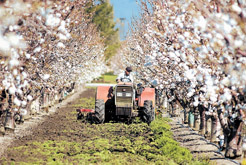
Cold adequate, rain fall not
Though local orchards may look barren from November through
February, the weather in the winter months can have an outcome on
spring and summer fruits and nuts.
Cold adequate, rain fall not
Though local orchards may look barren from November through February, the weather in the winter months can have an outcome on spring and summer fruits and nuts.
“Every year there is some kind of weather that affects the crops,” said Bill Coates, the director of the University of California Cooperative Extension in San Benito County. “Last year it was late frost. Some years it’s hail. Some years it’s not enough winter cold. This year it is going to be that there is not enough water resources.”
At press time, Hollister had received 7.92 inches of rain, of target for the average of 13.37 inches for the region.
“There is not going to be much available,” Coates said of the San Felipe water project that usually provides water for agricultural uses. “It may not even be the weather here, but the weather in other parts of the state with snow pack and runoff.”
Fruit and nut tree farmers can usually rely on ground water for their trees that can have deep root systems, but they often supplement that with irrigation in the summer.
“Sometimes the roots go down five to six feet and tap into some moisture from winter rainfall if we get enough of it to get down that far,” Coates said.
In terms of the cold weather needed to produce a hearty crop of fruits and nuts such as apricots, cherries and walnuts, it has been an average year.
“As it stands right now through using chilling hours, it’s a pretty good year,” Coates said. “We are up to 860 hours at or below 45 degrees. That indicates that it’s an average chilling year. It’s not excellent, but it is not bad.”
He said local farmers should expect “a fairly normal bloom and leafing out.”
“It’s been an average winter for chilling and below average for rainfall,” Coates said. “And having several years below average, we really need above average.”
He noted that for local crops rainSfall early in the winter season is better than spring showers.
“If we could put in an order we would put it in for Nov. 1 through Feb. 1,” he said. “Sometimes it becomes more of a hindrance than a help with an inability to get into a field because it is too muddy.”
The apricot trees will begin blooming in the next week, and rainfall during the blooming period can be problematic. The wet weather makes the trees susceptible to fungus, which Coates said most growers use a fungicide to combat.
“If we get continued wet weather, we will be spraying for brown rot and jacket rot,” Coates said.
The disease problem is worse with rainstorms during warmer weather in the 60s and “this is a relatively warm storm,” Coates said of the recent rainfall.
The forecast for the next week predicts continued rain showers.
“Most growers would be willing to put up with some inconvenience to get a little additional rainfall,” Coates said.
While apricots begin to bloom over the next couple weeks, cherries, walnuts and apples will not begin to bloom until late March or early April.









